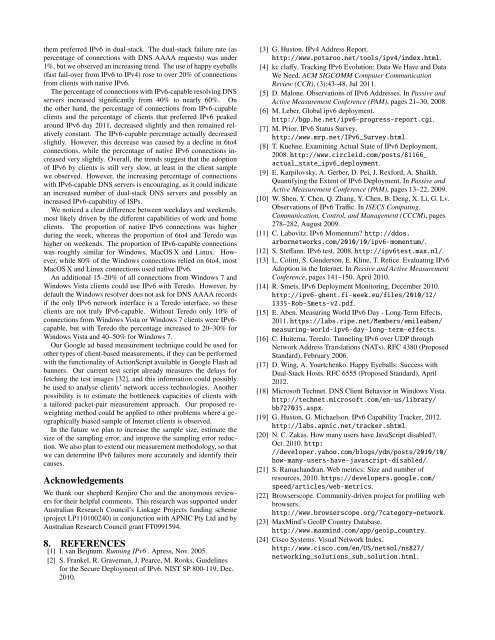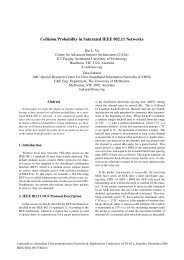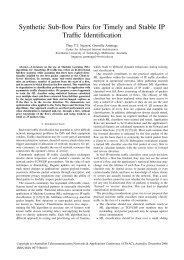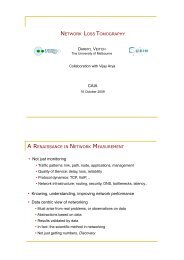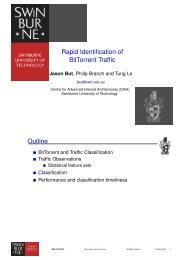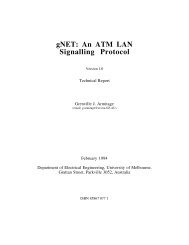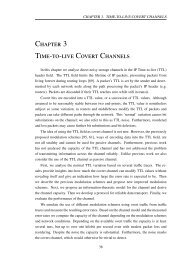Mitigating Sampling Error when Measuring Internet Client IPv6 ...
Mitigating Sampling Error when Measuring Internet Client IPv6 ...
Mitigating Sampling Error when Measuring Internet Client IPv6 ...
You also want an ePaper? Increase the reach of your titles
YUMPU automatically turns print PDFs into web optimized ePapers that Google loves.
them preferred <strong>IPv6</strong> in dual-stack. The dual-stack failure rate (as<br />
percentage of connections with DNS AAAA requests) was under<br />
1%, but we observed an increasing trend. The use of happy eyeballs<br />
(fast fail-over from <strong>IPv6</strong> to IPv4) rose to over 20% of connections<br />
from clients with native <strong>IPv6</strong>.<br />
The percentage of connections with <strong>IPv6</strong>-capable resolving DNS<br />
servers increased significantly from 40% to nearly 60%. On<br />
the other hand, the percentage of connections from <strong>IPv6</strong>-capable<br />
clients and the percentage of clients that preferred <strong>IPv6</strong> peaked<br />
around <strong>IPv6</strong> day 2011, decreased slightly and then remained relatively<br />
constant. The <strong>IPv6</strong>-capable percentage actually decreased<br />
slightly. However, this decrease was caused by a decline in 6to4<br />
connections, while the percentage of native <strong>IPv6</strong> connections increased<br />
very slightly. Overall, the trends suggest that the adoption<br />
of <strong>IPv6</strong> by clients is still very slow, at least in the client sample<br />
we observed. However, the increasing percentage of connections<br />
with <strong>IPv6</strong>-capable DNS servers is encouraging, as it could indicate<br />
an increased number of dual-stack DNS servers and possibly an<br />
increased <strong>IPv6</strong>-capability of ISPs.<br />
We noticed a clear difference between weekdays and weekends,<br />
most likely driven by the different capabilities of work and home<br />
clients. The proportion of native <strong>IPv6</strong> connections was higher<br />
during the week, whereas the proportion of 6to4 and Teredo was<br />
higher on weekends. The proportion of <strong>IPv6</strong>-capable connections<br />
was roughly similar for Windows, MacOS X and Linux. However,<br />
while 80% of the Windows connections relied on 6to4, most<br />
MacOS X and Linux connections used native <strong>IPv6</strong>.<br />
An additional 15–20% of all connections from Windows 7 and<br />
Windows Vista clients could use <strong>IPv6</strong> with Teredo. However, by<br />
default the Windows resolver does not ask for DNS AAAA records<br />
if the only <strong>IPv6</strong> network interface is a Teredo interface, so these<br />
clients are not truly <strong>IPv6</strong>-capable. Without Teredo only 10% of<br />
connections from Windows Vista or Windows 7 clients were <strong>IPv6</strong>capable,<br />
but with Teredo the percentage increased to 20–30% for<br />
Windows Vista and 40–50% for Windows 7.<br />
Our Google ad based measurement technique could be used for<br />
other types of client-based measurements, if they can be performed<br />
with the functionality of ActionScript available in Google Flash ad<br />
banners. Our current test script already measures the delays for<br />
fetching the test images [32], and this information could possibly<br />
be used to analyse clients’ network access technologies. Another<br />
possibility is to estimate the bottleneck capacities of clients with<br />
a tailored packet-pair measurement approach. Our proposed reweighting<br />
method could be applied to other problems where a geographically<br />
biased sample of <strong>Internet</strong> clients is observed.<br />
In the future we plan to increase the sample size, estimate the<br />
size of the sampling error, and improve the sampling error reduction.<br />
We also plan to extend our measurement methodology, so that<br />
we can determine <strong>IPv6</strong> failures more accurately and identify their<br />
causes.<br />
Acknowledgements<br />
We thank our shepherd Kenjiro Cho and the anonymous reviewers<br />
for their helpful comments. This research was supported under<br />
Australian Research Council’s Linkage Projects funding scheme<br />
(project LP110100240) in conjunction with APNIC Pty Ltd and by<br />
Australian Research Council grant FT0991594.<br />
8. REFERENCES<br />
[1] I. van Beijnum. Running <strong>IPv6</strong> . Apress, Nov. 2005.<br />
[2] S. Frankel, R. Graveman, J. Pearce, M. Rooks. Guidelines<br />
for the Secure Deployment of <strong>IPv6</strong>. NIST SP 800-119, Dec.<br />
2010.<br />
[3] G. Huston. IPv4 Address Report.<br />
http://www.potaroo.net/tools/ipv4/index.html.<br />
[4] kc claffy. Tracking <strong>IPv6</strong> Evolution: Data We Have and Data<br />
We Need. ACM SIGCOMM Computer Communication<br />
Review (CCR), (3):43–48, Jul 2011.<br />
[5] D. Malone. Observations of <strong>IPv6</strong> Addresses. In Passive and<br />
Active Measurement Conference (PAM), pages 21–30, 2008.<br />
[6] M. Leber. Global ipv6 deployment.<br />
http://bgp.he.net/ipv6-progress-report.cgi.<br />
[7] M. Prior. <strong>IPv6</strong> Status Survey.<br />
http://www.mrp.net/<strong>IPv6</strong>_Survey.html.<br />
[8] T. Kuehne. Examining Actual State of <strong>IPv6</strong> Deployment,<br />
2008. http://www.circleid.com/posts/81166_<br />
actual_state_ipv6_deployment.<br />
[9] E. Karpilovsky, A. Gerber, D. Pei, J. Rexford, A. Shaikh.<br />
Quantifying the Extent of <strong>IPv6</strong> Deployment. In Passive and<br />
Active Measurement Conference (PAM), pages 13–22, 2009.<br />
[10] W. Shen, Y. Chen, Q. Zhang, Y. Chen, B. Deng, X. Li, G. Lv.<br />
Observations of <strong>IPv6</strong> Traffic. In ISECS Computing,<br />
Communication, Control, and Management (CCCM), pages<br />
278–282, August 2009.<br />
[11] C. Labovitz. <strong>IPv6</strong> Momentum? http://ddos.<br />
arbornetworks.com/2010/10/ipv6-momentum/.<br />
[12] S. Steffann. <strong>IPv6</strong> test, 2008. http://ipv6test.max.nl/.<br />
[13] L. Colitti, S. Gunderson, E. Kline, T. Refice. Evaluating <strong>IPv6</strong><br />
Adoption in the <strong>Internet</strong>. In Passive and Active Measurement<br />
Conference, pages 141–150. April 2010.<br />
[14] R. Smets. <strong>IPv6</strong> Deployment Monitoring, December 2010.<br />
http://ipv6-ghent.fi-week.eu/files/2010/12/<br />
1335-Rob-Smets-v2.pdf.<br />
[15] E. Aben. <strong>Measuring</strong> World <strong>IPv6</strong> Day - Long-Term Effects,<br />
2011. https://labs.ripe.net/Members/emileaben/<br />
measuring-world-ipv6-day-long-term-effects.<br />
[16] C. Huitema. Teredo: Tunneling <strong>IPv6</strong> over UDP through<br />
Network Address Translations (NATs). RFC 4380 (Proposed<br />
Standard), February 2006.<br />
[17] D. Wing, A. Yourtchenko. Happy Eyeballs: Success with<br />
Dual-Stack Hosts. RFC 6555 (Proposed Standard), April<br />
2012.<br />
[18] Microsoft Technet. DNS <strong>Client</strong> Behavior in Windows Vista.<br />
http://technet.microsoft.com/en-us/library/<br />
bb727035.aspx.<br />
[19] G. Huston, G. Michaelson. <strong>IPv6</strong> Capability Tracker, 2012.<br />
http://labs.apnic.net/tracker.shtml.<br />
[20] N. C. Zakas. How many users have JavaScript disabled?,<br />
Oct. 2010. http:<br />
//developer.yahoo.com/blogs/ydn/posts/2010/10/<br />
how-many-users-have-javascript-disabled/.<br />
[21] S. Ramachandran. Web metrics: Size and number of<br />
resources, 2010. https://developers.google.com/<br />
speed/articles/web-metrics.<br />
[22] Browserscope. Community-driven project for profiling web<br />
browsers.<br />
http://www.browserscope.org/?category=network.<br />
[23] MaxMind’s GeoIP Country Database.<br />
http://www.maxmind.com/app/geoip_country.<br />
[24] Cisco Systems. Visual Network Index.<br />
http://www.cisco.com/en/US/netsol/ns827/<br />
networking_solutions_sub_solution.html.


